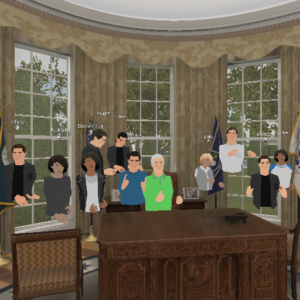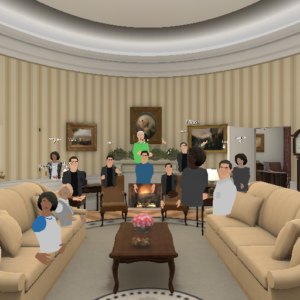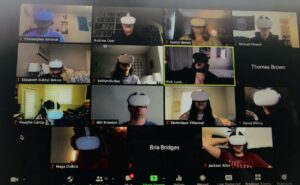The article below was written by Kelsey Klopfenstein of Florida State University Office of Communications and Leah Abounader, College of Communication and Information Media Intern.
TALLAHASSEE, Fla. — While most students taking remote classes are meeting via Zoom, a professor in Florida State University’s School of Communication has been using virtual reality (VR) to simulate a classroom space.
Professor Andrew Opel developed the Immersive Media Production class four years ago, and the technology has advanced exponentially since then. When faced with having to teach the hands-on class online, Opel successfully secured enough Oculus Quest 2 headsets for all students enrolled in the course.
“The students are learning 360 video production and immersive time-based media,” Opel said. “The first part of the semester, we worked in nonfiction action and just 2D, but then the second part we moved into a more open project that can be narrative or experimental. It’s 3D, so it’s got an image for the left and the right eye and depth.”
The 20 undergraduate and graduate students enrolled in the course use the headset for every class. Using the spatial.io software, students scanned photos of themselves to create a virtual avatar that moves and travels as they do during each class meeting. The result is a class that allows students to travel anywhere and see anything.
“By using the medium to teach the medium, this virtual classroom space offers a powerful, safe way to bring students together online and facilitate new forms of collaboration,” Opel said. “There’s a sense of exploration as soon as you go into these spaces, and students are more engaged because of it.”
To create the three-dimensional effect, students must learn camera production, editing and ambisonic sound, which is audio that’s recorded through four quadrants and then mixed accordingly. Ambisonic sound allows students to use audio cues to tell their audience where to look.
“It presents new challenges to directors and opportunities for audiences to be in a space and see a lot of what’s going on so that things aren’t excluded from the frame,” Opel said.
In addition to understanding the production of immersive 360 videos, students also need to watch a lot of immersive films to learn how to make one.
“We spend a lot of time watching pieces and one of the ways we’ve done that is through this virtual classroom,” Opel said.
The class uses the Engage VR platform to meet as avatars in a virtual space. Students can watch PowerPoint presentations in a virtual conference room, allowing everyone to sit and watch and interact with each other. One of the virtual rooms is a 360 planetarium where the class avatars gather on a platform and immerse themselves into 360 media, whether it be students’ work or professional work.
“Engage VR offers different virtual settings and we’ve done a variety of experiences and then we’ll come back and debrief,” Opel said. “For example, over the course of 30 minutes one day we sailed on a tall ship off the coast of Africa, explored the grasslands of central Florida, joined Elton John’s Farewell Yellow Brick Road VR experience and stopped by the Oval Office for a group photo.”
When they aren’t traveling the world, students use the Oculus Quest to learn the necessary skills and techniques needed to create immersive 360 videos. Many of the students have no prior experience with the headset or a VR environment, and the lack of textbooks on the subject requires them to make their own observations by watching the works of others. This learning curve urges students to critically evaluate the work of others so that they can incorporate those principles into their own work.
“By watching together in a virtual space, we are simulating the theater experience where we hear each other’s reactions in real time,” Opel said. “Most VR is consumed individually as a solo experience but EngageVR allows us to recreate a group audience experience.”
Senior Kaelyn Brown has had a tough time staying focused in remote classes but meeting her classmates in the virtual reality environment has kept her engaged and excited.
“Being in virtual reality for this online class has been an amazing experience and has kept me completely engaged in all the in-class activities,” Brown said. “It truly has me looking forward to each new week where we can learn more about the technology in an immersive learning environment.”
Using the skills she’s learned in Opel’s class, Brown and several classmates are planning to virtually livestream the pep rally portion Homecoming Live.
“The most interesting thing about this class is by far the technology, and Dr. Opel has done such a great job at helping us explore the technology in a natural and authentic way,” Brown said.
Michael Howell is a senior graduating this semester with a degree in digital media production. He describes the technology they’re using as cutting-edge and says it’s exciting to tell stories within a new medium.
“Meeting in class virtually is very interesting compared to a normal Zoom call because you can ‘walk’ around and interact with other students,” Howell said. “This virtual environment is great for visualizing concepts in a three-dimensional space, and I like being able to interact with others and the space around me.”
Opel said that other students have also said meeting in VR feels social.
“When your avatar gets close to somebody, you do feel that sense of personal space and that translates into the virtual world where you feel those personal boundaries, but also you feel then like if you want to get somebody’s attention, you can go over close to them and then it is more like you’re speaking directly to them,” Opel said.
Despite accelerated advances, VR is still a nascent and emerging technology that even those in the field are exploring and experimenting with. To understand how to make media that’s effective in this mode, Opel encourages students to notice their reactions and responses to determine what works and doesn’t work.
“VR is becoming really easy. It doesn’t require computer coding, it’s just a matter of having the headset, which is increasingly affordable, so there’s an ease with which this is possible,” Opel said. “I think it’s a really interesting tool with lots of potential.”




